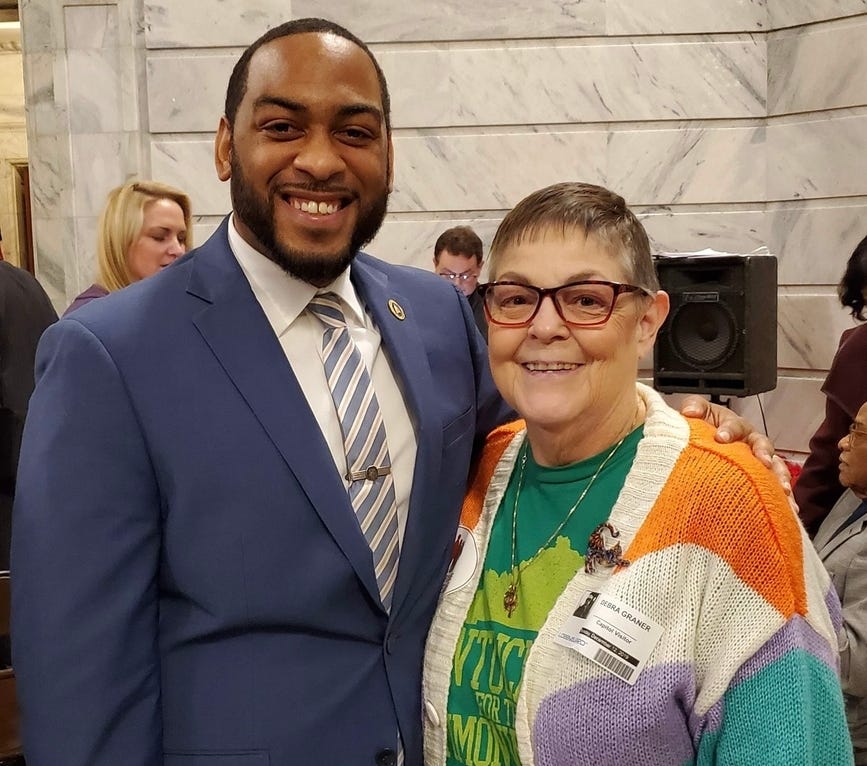How Voting Rights are Wronged by Felony Disenfranchisement

Ever wonder what it is like to lose the right to vote—and then gain it back again? Deb Graner knows what that feels like, which is why she fully understands how vital it is for people to participate in democracy.
In May, I spoke with Deb Graner and Claire Sandberg—a law student who helped her seek an expungement of her criminal record—about the rights restoration process for those convicted of a felony (listen to our conversation here). Ever since I first heard her story, Deb has impressed and inspired me with her openness and advocacy.
Deb was convicted of felony arson in 2011 and subsequently lost her right to vote under Kentucky law. She told me about that fateful night when a mix of depression, vodka, and candles changed her life forever. She never went to prison, and she finished her probation in 2017. But she still could not vote under Kentucky’s felon disenfranchisement law, which, she said, made her feel like less than a full citizen because it took away her right to vote for life.
In 2019, Kentucky Governor Andy Beshear issued an executive order to restore the right to vote for Deb and thousands like her who had completed their sentences. Then, with the help of Claire Sandberg, a student at the University of Kentucky’s Rosenberg College of Law, Deb secured an expungement of her record last year. Claire worked as a student with the College of Law’s legal clinic, which allows third-year students to engage in limited student practice under the supervision of the clinic’s director.
During our conversation, we walked through Deb’s journey through the process of re-enfranchisement and expungement and the broader movement to restore the right to vote for those convicted of a felony. Deb is now a proud advocate for rights restoration, through the organization Kentuckians for the Commonwealth. It meant so much to Deb, as a long-time voter before her conviction, to have her rights restored and her conviction expunged. She received news of the expungement during the holiday season, calling it the best Christmas present ever. Working with Deb also meant a lot to Claire, who explained that the process gave her valuable experience and reminded her of why she was in law school: to help people.
Deb mentioned an eye-opening statistic: felony convictions had disenfranchised over 300,000 citizens in Kentucky. While Governor Beshear reduced that number through an executive order in 2019, the number of people still unable to participate in the state’s democratic processes is staggering: as of 2023, 152,000 people—4.5% of the voting-age population—still cannot vote due to a felony conviction. That percentage is more than double the national rate. Moreover, because of the reality of the criminal legal system, felon disenfranchisement has a disproportionate impact on minority individuals.
Kentucky was one of the first states to enumerate lifetime felony disenfranchisement in its 1792 state constitution. In fact, felony disenfranchisement dates to the times of ancient Rome and Greece and has existed in the U.S. since the nation’s founding—though its effects are much more severe today. In 1974, the U.S. Supreme Court declared that the Constitution allows states to disenfranchise people convicted of a felony. In that case, Richardson v. Ramirez, the Court wrote that Section 2 of the Fourteenth Amendment permits the practice. The legal reasoning itself is somewhat convoluted, but it’s sufficient to say that the Court stretched the text of this provision to reach this result. (Those who want to learn more about this case and the Court’s tortured analysis should check out chapter 4 of my new book.)
The upshot is that in various states—such as Florida—there are hundreds of felonies on the books that can disqualify an individual.
Disenfranchisement because of a felony conviction affects millions of Americans nationwide; one report estimates that 4.4 million people no longer enjoy the right to vote. This disenfranchisement can affect election outcomes. Consider, for example, Kentucky gubernatorial elections. While a reliably red state for federal elections, Kentucky’s contest for governor has been increasingly competitive. In 2023, Democrat Andy Beshear’s margin of victory was 67,000 votes; in 2019, he won by just 5,000. The state’s number of disenfranchised individuals—152,000—dwarfs both of those margins. There are close elections in every state across the nation, of varying consequence: in the 2000 presidential election, George W. Bush won the state of Florida by 537 votes, and with Florida came the presidency. Yet thousands of people could not vote that year in the Sunshine State.
Outside of its effect on elections, disenfranchisement because of a felony conviction hurts people. It stigmatizes individuals, removing them, sometimes permanently, from the democratic process. Is it really fair to judge people—forever—for the single worst decision that they have ever made, especially after they have done their time?
Yet there have been positive developments. The number of disenfranchised individuals has steadily decreased over the years because of changes in state policies, and, today, most states have a system to re-enfranchise individuals after they have served their sentence. There is a bipartisan push to change the law in many places. This process started shortly after the Ramirez decision: California, the state where Ramirez arose, amended its constitution to end lifetime disenfranchisement in 1974. In 2018, Floridians widely supported an amendment to automatically re-enfranchise those with a felony conviction after they serve their sentence—though the Florida legislature then passed a law requiring these returning citizens to pay all fines and fees, including interest, associated with their sentence. So, the effects of the Florida re-enfranchisement were not as big as proponents initially hoped. That said, the restoration of rights in Florida, Kentucky, and other places represents a concrete positive shift toward creating a more inclusive electorate.




